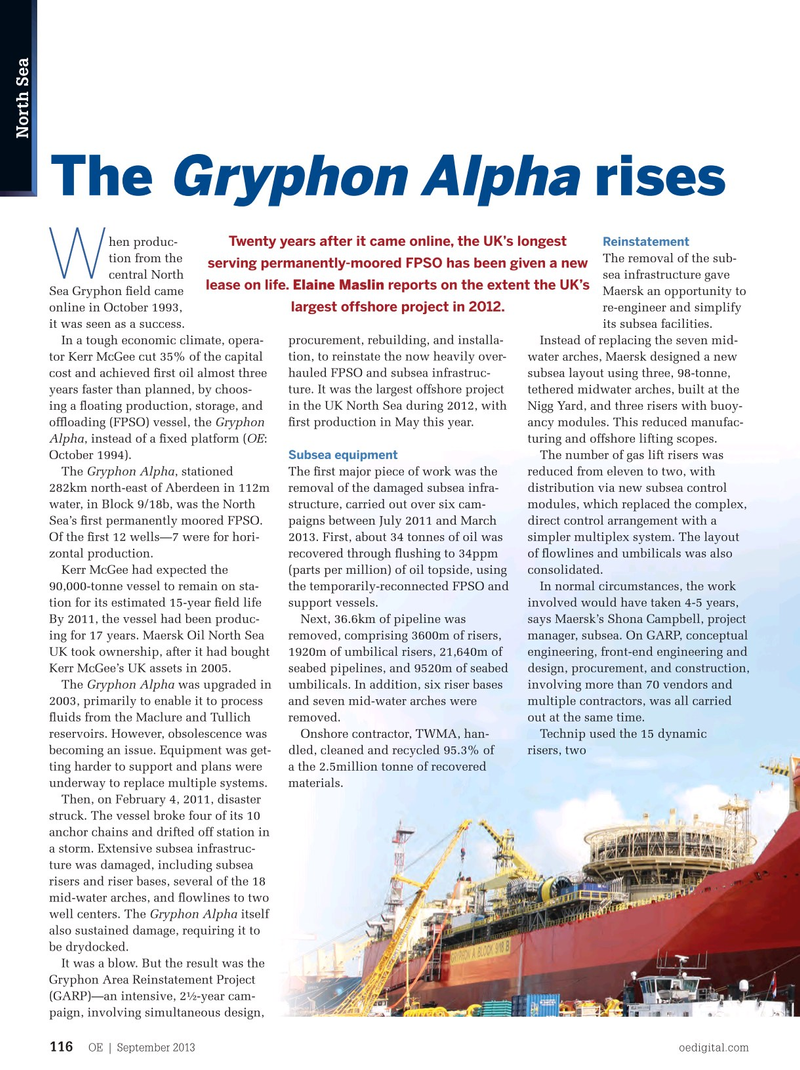
Page 114: of Offshore Engineer Magazine (Sep/Oct 2013)
Read this page in Pdf, Flash or Html5 edition of Sep/Oct 2013 Offshore Engineer Magazine
North Sea
The rises Gryphon Alpha hen produc- Reinstatement
Twenty years after it came online, the UK’s longest tion from the The removal of the sub- serving permanently-moored FPSO has been given a new central North sea infrastructure gave
W lease on life. Elaine Maslin reports on the extent the UK’s
Sea Gryphon feld came Maersk an opportunity to online in October 1993, re-engineer and simplify largest offshore project in 2012.
it was seen as a success. its subsea facilities.
In a tough economic climate, opera- procurement, rebuilding, and installa- Instead of replacing the seven mid- tor Kerr McGee cut 35% of the capital tion, to reinstate the now heavily over- water arches, Maersk designed a new cost and achieved frst oil almost three hauled FPSO and subsea infrastruc- subsea layout using three, 98-tonne, years faster than planned, by choos- ture. It was the largest offshore project tethered midwater arches, built at the ing a foating production, storage, and in the UK North Sea during 2012, with Nigg Yard, and three risers with buoy- offoading (FPSO) vessel, the Gryphon frst production in May this year. ancy modules. This reduced manufac-
Alpha, instead of a fxed platform (OE: turing and offshore lifting scopes.
October 1994). The number of gas lift risers was
Subsea equipment
The Gryphon Alpha, stationed The frst major piece of work was the reduced from eleven to two, with 282km north-east of Aberdeen in 112m removal of the damaged subsea infra- distribution via new subsea control water, in Block 9/18b, was the North structure, carried out over six cam- modules, which replaced the complex,
Sea’s frst permanently moored FPSO. paigns between July 2011 and March direct control arrangement with a
Of the frst 12 wells—7 were for hori- 2013. First, about 34 tonnes of oil was simpler multiplex system. The layout zontal production. recovered through fushing to 34ppm of fowlines and umbilicals was also
Kerr McGee had expected the (parts per million) of oil topside, using consolidated.
90,000-tonne vessel to remain on sta- the temporarily-reconnected FPSO and In normal circumstances, the work tion for its estimated 15-year feld life support vessels. involved would have taken 4-5 years,
By 2011, the vessel had been produc- Next, 36.6km of pipeline was says Maersk’s Shona Campbell, project ing for 17 years. Maersk Oil North Sea removed, comprising 3600m of risers, manager, subsea. On GARP, conceptual
UK took ownership, after it had bought 1920m of umbilical risers, 21,640m of engineering, front-end engineering and
Kerr McGee’s UK assets in 2005. seabed pipelines, and 9520m of seabed design, procurement, and construction,
The Gryphon Alpha was upgraded in umbilicals. In addition, six riser bases involving more than 70 vendors and 2003, primarily to enable it to process and seven mid-water arches were multiple contractors, was all carried fuids from the Maclure and Tullich removed. out at the same time.
reservoirs. However, obsolescence was Onshore contractor, TWMA, han- Technip used the 15 dynamic becoming an issue. Equipment was get- dled, cleaned and recycled 95.3% of risers, two ting harder to support and plans were a the 2.5million tonne of recovered underway to replace multiple systems. materials.
Then, on February 4, 2011, disaster struck. The vessel broke four of its 10 anchor chains and drifted off station in a storm. Extensive subsea infrastruc- ture was damaged, including subsea risers and riser bases, several of the 18 mid-water arches, and fowlines to two well centers. The Gryphon Alpha itself also sustained damage, requiring it to be drydocked.
It was a blow. But the result was the
Gryphon Area Reinstatement Project (GARP)—an intensive, 2½-year cam- paign, involving simultaneous design,
OE | September 2013 oedigital.com 116 000_OE1013_geofocus1-gryphon.indd 116 8/17/13 5:23 PM

 113
113

 115
115